Rehab Agency’s insight tool that analyzes real-time social trends for actionable brand insights
Use of Generative Marketing AI (“GenAI”) has skyrocketed among businesses of all sizes for many reasons: The promise of cost and time savings, personalization at scale, easier and better customization, and its ability to generate thought starters and stimuli for marketing content and new products and service development. After speaking with a wide spectrum of relatively recently minted experts (due to the newness of the mega technology), 6 areas emerged as critical for brands to gain competitive advantage through AI marketing.
“Dumbed Down” Marketing
Firms that rely exclusively on outputs from GenAI’s foundational model database layer, without thoughtfully enriching it, risk getting back content and ideas that are generic and not fully aligned with their business goals and challenges. Additionally, most GenAI services, including Open AI’s ChatGPT4, rely on models trained on information with a cutoff date of September 2021, resulting in outdated outputs.
A “dumbed down” way to use AI is to maximize cost savings by limiting human intervention. Feeding GenAI obvious prompts for given use cases and then publishing the creative output without human interpretation and modification, can result in mediocre creative at best, and at worst, creative that is inaccurate and out of touch with how targets will receive it. With micro-targeting becoming the norm, the proliferation of social media, and pressure on firms to post every day, the amount of content for brands is staggering. Pressure to increase content generation speed and volume while simultaneously lowering creation costs, increase the temptation to use AI as a replacement rather than a supercharger for a firm’s marketing efforts. As auto-generated prompts become more widespread, the risk is that competitors will ask the same questions for given tasks and get back similar answers.
According to Jared Zoneraich, Founder at PromptLayer, a platform for tracking, managing and sharing GPT prompts, “for many companies, getting 80% of the way there is easy, and good enough for now. It’s the last mile though that can really distinguish creative”. Done well, GenAI can create more work and stimulate more “real” thinking because the responses and thought starters that come back spark many new paths to explore, each of which can offer further investigation, and on & on, a lot like tree branching. Chains of as many as 10 to 20 prompts using sequential logic can be required.
Here are 6 critical considerations that emerged to smartly gain a competitive advantage using GenAI for brand marketing.
1) High Quality Data Sources & Examples
As the saying goes, garbage in equals garbage out. AI models are no different. To get the best outputs from using AI, two critical areas are data and context.
Organizations that choose to build or customize their own models need to focus on data needed for the specific the job to be done, and to train the content generating models to look and feel like their brands. For firms looking to avoid the cost of building and maintaining their own models, context will be more relevant. Context can loosely be defined as the information the model needs to get the end result. Data overlayed to the foundational GenAI layer that can significantly enrich output include brand strategies and goals, real-time brand and category social listening, brand and competitor sales, target audience profiles, trend forecasts, prior marketing examples with results if available, and chatbot or recorded human conversations at each stage of the customer journey.
An interesting example of differentiating overlay data was provided by Sebastian Errazuriz, who is writing a book about the social impact of GenAI: satellite data revealing lights at night over time in an area, used to measure relative income growth. Another rich source of data is from partners, like food ingredient suppliers who sell to restaurants, observe trends, and interview cutting edge chefs globally. Shein, the fashion retailer, taps into data shared by its extensive network of garment suppliers who manufacture for other retailers and have a broad view of what’s trending in fashion. Structured data from posts of specific interest bloggers and YouTubers with large followings are other good overlay data sources.
Tim Rogers, Founder at Rehab Agency, views GenAI as “a creative partner you can spar with”. One of Rehab Agency’s most important use cases is evolving creative briefs based on real time inputs like social media conversations, so the creative adapts with the speed of culture. When possible, Rehab uses closed-loop feedback systems, proprietary to some firms, that incorporate real-time responses and consumer actions after seeing posts.
2) Experimentation And Broad Perspectives In Generating Prompts
While use of auto-generated prompts will soon be widespread, there’s no substitute yet for insightful prompts generated by humans with detailed context for AI models to process. Ieva Gaigala, Head of Community at Newfund, a VC focused on BrainTech, shared how she gets the best AI output by asking ChatGPT to provide her with 20 questions it needs answers to, in order to generate the most on-target content.
Chris Rodgers, Founder and CEO of SEO agency CSP, develops “business-first” SEO strategies around clients’ business goals, personas, and unique value propositions before using GenAI to execute keyword research and content strategy, unlike many firms that start with keyword data and tool outputs. The result is more revenue growth and ROI, beyond rankings and traffic, due to better performance on user actions like website transactions, form fills, content shares, and backlinks.
Characteristics the best prompt engineers possess include critical thinking, curiosity, and a love of experimentation, tinkering, and learning through trial and error. Understanding strategic goals and how the information will be utilized are also key. Sebastian Errazuriz used the music analogy that “the best prompt engineers are not composers, but more like DJ’s, always mixing other people’s work”. Hiring lower cost, junior people who lack broad perspectives risks jeopardizing output quality.
While many question AI’s ability to come up with totally new ideas because it draws on what has already been done, it seems great at generating thought starters and stimuli for many different types of creativity. As AI models gets more specific direction, I personally believe they will become more creative. The level and type of questions asked can impact how truly creative the ideas are that come back. In my book, Catalyzing Innovation, I provide 63 different types of innovation with 1100 cross-sector, global examples, to encourage new product design teams and marketers to think more broadly about the areas in which they can innovate. This same direction can be given to AI models, for example: combining things innovation, size, shape, material, color, business model, pricing, process, asymmetry, retro innovation and more.
Other effective prompt approaches include asking GenAI for contrary opinions, and framing problems in different ways to get back a broader spectrum of responses. For important work challenges, Maggie Castaldo, Omnichannel Category manager at Nestle Purina, now spends more times thinking about different angles she can enter into ChatGPT, to get more detailed and well-rounded answers.
3) Non-Obvious Yet Meaningful Use Cases For GenAI
Some seemingly small use cases can have outsized importance. Examples include:
– Digital innovation agency Rehab, creates AI tools that take real-time user comments from social media as stimuli for creative insights, like a Subreddit post about nostalgia the video game Assassin’s Creed evoked in players by reminding them of when they first started playing. Rehab turned the insight into a creative post that resonated well with that audience.
– Rehab also creates virtual AI personas to test creative for “real” target user reactions to posts being considered. The Agency validates creative ideas via AI virtual persona affinity scores.
– Netflix uses AI to optimize thumbnail images for which movies people chose.
– An herbal remedies shop uses GenAI to determine what the FDA allows it to say about its products, since the shop and site are not allowed to practice or prescribe medicine.
– Newfund, the VC focused on BrainTech, uses GenAI to explain what BrainTech encompasses to clients, including the key segments of that industry.
– The Innovation Board outlines 20 use cases for how ChatGPT can be utilized at different stage of the new product innovation process. I plan to use it as a teaching tool for my New Products course at NYU Stern’s MBA program this fall.
– “Tucker Fort, Executive Director & Partner at Smart Design said their design teams have started creating mood boards for new product and service ideas using GenAI in the earlier stages of the design process. Vs. traditional image collages, GenAI can quickly integrate different visual idea components into a single expression that’s easier for potential users to mentally process.
– Legendary typeface genius, Craig Ward, uses GenAI to explore more different creative avenues faster. Not only is the time-savings astonishing, but it’s now possible to consider and experiment with even more different creative directions.
Companies will gradually get used finding meaningful GenAI use cases as a permanent way of thinking. To speed up the transition in firms, I believe employees should be rewarded for clever new uses, and those examples should be shared within the company to inspire others.
4) KPIs To Drive Better Results
Developing the right Key Performance Indicators (“KPIs”) is critical. Will the brand’s KPIs be defined as # of posts, increased clickthrough on content, awareness levels, post engagement, conversion, or time to produce a campaign in business days? Mike Menkes, SVP Analytic Partners provided the example of optimizing for clicks vs. conversion. A brand can achieve lots of clicks for the wrong reasons, and conversion is the ultimate goal for most businesses.
5) Interpretation, Screening, And Application Of GenAI Outputs
Who is reviewing, interpreting, and applying GenAI outputs matter tremendously, as well as at what stage of the process players become involved? On the surface, the short-term, cost-effective way to apply the output is to go with what’s been generated automatically, without modification. According to Sebastian Errarzuriz, investing in the right, truly valuable, seasoned, and multi-talented individuals who can draw on a breadth of relevant knowledge, can result in meaningfully better and more important insights and creative applications. Skills to look for in prompt engineers, beyond data analytics, include understanding business strategy, deep industry knowledge, consumer insights, trend forecasting, and marketing communications. Another option for broader perspective interpretation in certain instances, is to create multifunctional teams to digest and apply GenAI outputs.
Andrew McKechnie, Chief Brand & Creative Officer of leading tech brands like Apple, believes “AI’s ability to drive creative innovation will depend on a brand’s capacity to curate authentic experiences throughout the creative process. He stated that authenticity applying GenAI outputs will be key, similar to how curators of culture are often purveyors of new ideas or movements in fashion, music, and design. Those who can apply high-fidelity concepts that leverage knowledge across mediums and cultural insights will be more successful in creating authentic, original GenAI”.
It’s important that creatives be involved in contributing insight generating questions to prompt engineers from the start. Sandra Alvarez, GM at PHD Media, part of Omnicom Media, expressed concern that “a lack of learning and experience of those who enter the creative thinking process halfway through because the earlier portion was done by AI, will never know or experience doing all steps of creative thinking. Everything not trained is lost, and she fears in the future, creatives will be incomplete and less creative, with less intuition and very dependent on AI.”
6) Composability
Geoff Renaud, CMO and Co-founder at brand experience agency Invisible North shared that even with innovative creative ideas spurred by GenAI, brands need composability: a mix of AI tools to technically produce ads that break through and feel original. Integrated multimodal tech stacks are becoming easier for a range of firms to access. They’re a huge priority for tech firms like Google, Microsoft, Amazon and Adobe to offer, and the race is on among these giants to be first and best (a moving target). While past tools focused on just text, just visuals, or just videos, new platforms like Google’s Gemini aim to combine multimodal capabilities seamlessly.
Brennan Woodruff, cofounder of GoCharlie.ai, a generative AI platform that develop multimodal models stated “In the future, you’ll see many more offerings powered by multiple models interacting with one another. The promise of multimodal is a single model capable of understanding and producing outputs in multiple mediums that vastly reduces operating costs and increases quality of results. Think of modalities like senses. Without all our senses working together, experiences wouldn’t be as rich. That’s what multimodal AI solutions are poised to deliver.”
Key Questions CMOs Need To Ask Themselves
GenAI understandably overwhelming for many businesses with so many different aspects, so much to learn, and it’s moving so fast. Here are 7 important questions senior execs in Strategy, Marketing, Consumer Insights, and Tech should be asking:
1) What types of databases can be added to the foundational GenAI layer to provide more insightful, strategic, and creative outputs?
2) What use cases can GenAI be applied to beyond the most obvious? Is the organization being trained and rewarded for coming up with use cases that can meaningfully impact sales and enhance the brand’s position in the market?
3) What should be the profiles of the firm’s prompt engineers (internally and/or externally at suppliers)? Are they obsessed with constantly experimenting to achieve the best results?
4) Do the talent profiles of GenAI interpreters maximize the potential of the mega tool, and/or should individuals with different functional expertise collaborate on interpretations and applications?
5) Are the generative AI KPIs the right ones to result in not just conversation, but positive engagement, brand image enhancement, and long-term success?
6) Does the firm have the right tech stack and creative team applying GenAI suggestions, for the creative to positively stand out and spawn sharing and advocacy?
7) Should proprietary GenAI algorithms, customized data overlays, and prompts be exclusively developed in-house, through external specialists, or through some combination, to maximize and protect that competitive advantage?
Credit: Source link











